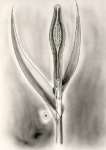
Grasses may reproduce sexually by seed (sexual reproduction), or asexually via vegetative propogation (tillers which arise from adventitious buds on culm nodes, rhizomes, and stolons). This section deals only with sexual reproduction involving flowers, pollination, and seeds.
With certain exceptions (see apomixis), to produce seed a grass plant must produce flowers with male and female parts. The initial steps leading to sexual reproduction occur when the grass plant enters the transition stage where the shoot becomes ""induced to flower."" Floral induction leads to the gradual conversion of the vegetative shoot apex (growing point) to a floral bud. Within a few days, zones on intercalary meristem associated with the nodes and internodes of the developing culm give rise to a jointed stem, most easily recognized on bamboo. The uppermost internode of the culm is called the peduncle and supports the seed head (inflorescence).
Seed heads of grasses are commonly classified according to certain morphological characteristics. The inflorescence may be a panicle, spike, or a raceme (see Grass Strutures - Inflorescences). Each of these types occurs in various modifications and descriptive designations are given such as compact panicle, racemose, branched and digitate racemes, digitate spike, multiple spikes, etc. Each type, however, has a spikelet of some form. A spikelet is a pair of variously shaped glumes (modified leaves) with enclosed floret(s).
The spikelet may be sessile to the rachis (attached to the central axis of the inflorescence) with no supporting small stems called pedicels. This is characteristic of spike inflorescences. With racemes, the spikelet is supported by a short pedicel attached directly to the rachis. In a panicle type of inflorescence, spikelets are supported by a pedicel of varying lengths, the pedicel itself representing a subdivision of the panicle branch. Panicle inflorescences have branches and pedicels while racemes have only pedicels. Spikes have neither.
Within the spikelet, we find one to several florets (modified flowers). With certain grasses, sterile florets (no reproductive organs) may be found in close association with fertile florets (Phalaris, Panicum); in other grasses the florets may be unisexual (either male or female) as with Buchloe and Zea maize.
A floret is comprised of two bracts (lemma and palea) which enclose the reproductive organs. Stamens, comprised of anthers with supporting filaments, represent the male sex. The pistil, comprised of the stigma, style, and ovary represent the female sex. At anthesis, lodicules comprised chiefly of spongy tissue in the base of the floret, swell due to the absorption of water thereby spreading apart the lemma and palea. This allows pollen grains housed in the anthers to escape the immediate environment and fertilize adjacent flowers (cross pollination). Certain grasses are largely self-pollinated because anthers rupture and release pollen before lodicule activity.
Seed production in the absence of conventional fertilization of the female organ is called apomixis. Shedding of pollen appears to stimulate systems in the embryo wherein the ovary develops a seed which, when planted, will produce a new plant exactly like the mother plant.
Among grass species, sexual reproduction may occur with few restraints, however, the processes are often constrained by mechanisms which govern whether or not cross-breeding is possible. Some of these constraints are listed below.
For conservation harvest (hay and silage) the emergence of seedheads signals the developmental phase which represents a favorable compromise between obtaining maximum forage yield and preserving high quality. Somewhat higher yields may be obtained by further delaying the harvest but lignification increases making the forage less digestible. Lactating dairy cows may consume such hay when offered free choice but that would voluntarily reduce grain consumption and production would decrease. Such hay may be useful for maintenance energy. High quality forage is needed for maximum milk production and body weight gain.

Delaying conservation harvests beyond "early heading" may contribute to a degree of summer dormancy for certain cool-season grasses. Timely removal of seedheads triggers aftermath shoot growth before the onset of arid conditions. Aftermath shoots must produce many new roots so mid summer production is favored by triggering early growth of aftermath by timely conservation harvest or by clipping pastures to remove ungrazed seedheads. In some regions (Australia) this is called "topping" your pasture. (See scenario section)